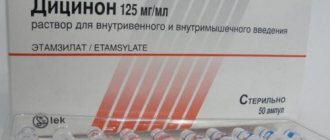Pharmacodynamics and pharmacokinetics
The medication stimulates the process of platelet release from the bone marrow and enhances their formation. The drug has antiplatelet and angioprotective effects. The drug helps stop bleeding, increases the rate of formation of the primary thrombus , etamsylate enhances retraction, has no effect on prothrombin time , fibrinogen concentration. With repeated use of the drug, thrombus formation increases. Dicynone reduces diapedesis of formed and blood elements from the vascular bed, reduces fluid output, and has a positive effect on microcirculation . The drug does not affect the normal indicators and parameters of the hemostasis system. Dicynone is able to restore altered bleeding time in various diseases.
The hemostatic effect is felt after 10-15 minutes. The peak level of the active substance is reached an hour after administration. It is excreted unchanged on the first day almost entirely in the urine.
Dicynon solution for intravenous and intramuscular administration, 125 mg/ml amp. 2ml No. 50
Indications
Prevention and stopping of bleeding: parenchymal and capillary bleeding (including traumatic, in surgery during operations on highly vascularized organs and tissues, during surgical interventions in dental, urological, ophthalmological, otolaryngological practice, intestinal, renal, pulmonary bleeding, metro- and menorrhagia with fibroids and others), secondary bleeding due to thrombocytopenia and thrombocytopathy, hypocoagulation, hematuria, intracranial hemorrhage (including in newborns and premature infants), nosebleeds due to arterial hypertension, bleeding caused by taking medications, hemorrhagic diathesis (including Werlhoff disease, von Willebrand-Jurgens disease, thrombocytopathy), diabetic microangiopathy (hemorrhagic diabetic retinopathy, repeated retinal hemorrhage, hemophthalmos).
pharmachologic effect
A hemostatic agent, it also has angioprotective and proaggregant effects. Stimulates the formation of platelets and their release from the bone marrow. The hemostatic effect, caused by the activation of thromboplastin formation at the site of damage to small vessels and the decrease in the formation of prostacyclin PgI2 in the vascular endothelium, promotes increased adhesion and aggregation of platelets, which ultimately leads to stopping or reducing bleeding. Increases the rate of formation of the primary thrombus and enhances its retraction, has virtually no effect on the concentration of fibrinogen and prothrombin time. Doses of more than 2-10 mg/kg do not lead to a greater effect. With repeated administrations, thrombus formation increases. Possessing antihyaluronidase activity and stabilizing ascorbic acid, it prevents the destruction and promotes the formation of mucopolysaccharides with high molecular weight in the capillary wall, increases the resistance of capillaries, reduces their fragility, and normalizes permeability in pathological processes. Reduces fluid leakage and diapedesis of blood cells from the vascular bed, improves microcirculation. Does not have a vasoconstrictor effect. Restores pathologically altered bleeding time.
It does not affect the normal parameters of the hemostatic system. The hemostatic effect with intravenous administration of etamsylate occurs within 5-15 minutes, the maximum effect appears after 1-2 hours. The effect continues for 4-6 hours, then gradually weakens over 24 hours; with intramuscular administration, the effect occurs within 30-60 minutes.
Drug interactions
Administration of ethamsylate at a dose of 10 mg/kg 1 hour before the administration of dextrin solutions with an average molecular weight of 30,000-40,000 prevents the antiaggregation effect of the latter; administration of ethamsylate after dextran solutions does not have a hemostatic effect.
A combination with aminocaproic acid and menadione sodium bisulfite is possible.
Etamsylate is pharmaceutically incompatible (in the same syringe) with other drugs.
Dosage regimen
Used orally, intramuscularly, intravenously, locally, subconjunctivally, retrobulbarly. The dosage regimen is set individually, depending on the indications, clinical situation, patient's age, and dosage form used.
Contraindications for use
Hypersensitivity to etamsylate, acute porphyria, hemoblastosis in children, thrombosis, thromboembolism; pregnancy, lactation (breastfeeding); children under 3 years of age (for oral administration).
Carefully
History of thrombosis, thromboembolism; bleeding due to an overdose of anticoagulants; liver and/or kidney dysfunction.
Use in children
It can be used in children according to indications, in doses, regimens and dosage forms recommended according to age. It is necessary to strictly follow the instructions in the instructions for etamsylate preparations regarding contraindications for the use of specific dosage forms of etamsylate in children of different ages.
Restrictions for children
Use with caution
Use in elderly patients
Use with caution in elderly patients to avoid the risk of exacerbation of chronic diseases.
Restrictions for elderly patients
Use with caution
Use for liver dysfunction
Use with caution in patients with impaired liver function.
Restrictions for liver dysfunction
Use with caution
Use during pregnancy and breastfeeding
Contraindicated for use during pregnancy and breastfeeding.
Restrictions when breastfeeding
Contraindicated
Restrictions during pregnancy
Contraindicated
Use for renal impairment
Use with caution in patients with impaired renal function.
Restrictions for impaired renal function
Use with caution
special instructions
Before starting treatment, other causes of bleeding should be excluded.
Etamsylate is not effective in patients with a low platelet count.
For hemorrhagic complications associated with an overdose of anticoagulants, it is recommended to use specific antidotes.
The use of etamsylate in patients with impaired blood coagulation system parameters is possible, but it should be supplemented by the administration of drugs that eliminate the identified deficiency or defect of coagulation factors.
Due to the increased risk of a pronounced decrease in blood pressure with parenteral administration of etamsylate, caution should be exercised in patients with unstable blood pressure or a tendency to hypotension.
Side effect
From the digestive system:
often - nausea, diarrhea, heaviness in the epigastric region.
For the skin and subcutaneous tissues:
often - skin rash; frequency unknown - facial skin flushing.
From the nervous system:
often - headache; frequency unknown - dizziness, paresthesia of the lower extremities.
From the cardiovascular system:
very rarely - thromboembolism, marked decrease in blood pressure.
From the hematopoietic system:
very rarely - agranulocytosis, neutropenia, thrombocytopenia.
From the musculoskeletal system:
very rarely - arthralgia.
Other:
often - asthenia; very rarely - allergic reactions, fever.
Possible product names
- Dicynon solution for intravenous and intramuscular administration, 125 mg/ml amp. 2ml No. 50
- DICINON 250 MG AMP IV V/M 2 ML No. 50
- DICYNON 0.125/ML 2ML N50 AMP R-R V/V V/M
- DICYNON RR IV, IM INJECTED 125 MG/ML 2 ML. X50
- DICYNON SOLUTION FOR INJECTION. FOR IV AND IM ADMINISTRATION 250 MG AMP 2 ML No. 50
- DICYNONE 125MG/ML SOLUTION FOR IV AND IM INSTRUCTION. 2ML AMP. X50 B M (R)
- (Dicynone) Dicynone solution for IV and IM administration, 125 mg/ml amp. 2ml No. 50
Indications for use of Dicinone
What is Dicynon in tablets and ampoules for?
The medicine is prescribed to stop bleeding and prevent it: capillary, parenchymal bleeding (postoperative, traumatic, after dental interventions, intestinal, renal, pulmonary bleeding). The drug is prescribed for secondary bleeding due to thrombocytopathy , thromphocytopenia, hematuria, hypocoagulation, intracranial hemorrhage, hemorrhagic vasculitis , drug-induced bleeding, hemorrhagic diathesis . Indications for the use of Dicinon are repeated retinal hemorrhages, diabetic retinopathy, Werlhof's disease. Dicinone for menstruation is prescribed for heavy menstruation.
Nosological classification (ICD-10)
- D65-D69 Bleeding disorders, purpura and other hemorrhagic conditions
- H35 Other retinal diseases
- H35.6 Retinal hemorrhage
- H43.1 Vitreous hemorrhage
- I78.8 Other diseases of capillaries
- I79.2 Peripheral angiopathy in diseases classified elsewhere
- N92 Heavy, frequent and irregular menstruation
- N93 Other abnormal bleeding from the uterus and vagina
- R58 Bleeding, not elsewhere classified
- Z100* CLASS XXII Surgical practice
Instructions for use of Dicinone (Method and dosage)
The medicine is taken orally, administered intramuscularly, intravenously. In ophthalmology it is used retrobulbarly. Single dose – 0.5 grams (tablets), 0.25 grams (parenteral). To prevent bleeding during surgical interventions, Etamzilat is administered one hour before surgery. Dicynone for menstruation, pulmonary, intestinal bleeding: 0.5 grams daily, course of treatment for 5-10 days. For diseases of the blood system, hemorrhagic diathesis, diabetic angiopathy, take 0.75 grams, duration of therapy is up to two weeks. To prevent postoperative bleeding, Dicynon is taken in an amount of 8 mg/kg.
Hemorrhagic syndrome: three times a day, 6-8 mg/kg, duration of administration up to two weeks, if necessary, repeat the course after a week.
Diabetic microangiopathy (hemorrhages): intramuscularly 0.25 grams three times a day, injections are given for 3 months. A sterile swab soaked in ethamsylate can be applied to the wound surface to stop bleeding.
Dicinon tablets, instructions for use
Usually take about 15 mg/kg per day. That is, 1-2 tablets at a time, 3 times every 24 hours.
Children aged three to twelve years take half the adult dose.
Dicinon injections, instructions for use
Dicynon is administered intravenously or intramuscularly. Usually 1-2 ampoules 3 times a day.
Instructions for use of Dicinon during menstruation
Used only with the permission of the attending physician. For heavy periods, 2 tablets are prescribed 3 times a day 3-5 days before menstruation and for five days after their onset. It is recommended to repeat the course at the next menstruation to consolidate.
It is not recommended to use the drug to stop menstruation.
How to take Dicinon for uterine bleeding
Only under the supervision of a doctor. For uterine bleeding, it is recommended to take Dicinon by injection, 1-2 ampoules every 6 hours until the bleeding stops or the risk of its recurrence disappears.
Side effects
While using the medication, the following reactions from the body are likely:
- redness of the facial skin, feeling of heat;
- changes in the sensitivity of the lower extremities, their numbness;
- decreased blood pressure;
- headache;
- dizziness;
- drowsiness, muscle weakness;
- for diseases of the gastrointestinal tract: epigastric pain, heartburn, nausea, loss of appetite, heaviness in the abdomen.
Dicynon's analogs
Level 4 ATC code matches:
Water pepper extract
Etamzilat
The main analogue is a drug that has the same name as the main active ingredient - Etamzilat .
Which is better: Dicynon or Tranexam?
Tranexam is considered a more effective drug for stopping bleeding.
Reviews of Dicynon
Reviews of Dicinone in tablets and ampoules indicate that the drug is a very effective remedy for stopping bleeding. It tastes bitter.
Reviews for menstruation
They perfectly help with heavy menstruation, for which they are often taken.
Reviews during pregnancy
Recommended with caution, but generally no side effects have been reported. Expectant mothers take this drug, pregnancy is successful.
For uterine bleeding
Used under the supervision of a physician. Helps stop uterine bleeding. However, the effect may not last long.
Dicinon price, where to buy
The price of Dicinon in tablets is approximately 380 rubles per package of 100 pieces. How much do tablets cost in Ukraine? You can buy a package for 320-340 UAH.
The price of Dicinon ampoules is 530 rubles for 50 pieces. The cost in Ukraine is 350-380 UAH.
- Online pharmacies in RussiaRussia
- Online pharmacies in UkraineUkraine
- Online pharmacies in KazakhstanKazakhstan
LuxPharma* special offer
- Dicynone amp.
250 mg 2 ml (125 mg/ml) No. 10 RUB 1,290 order
ZdravCity
- Dicynon tablets 250 mg 100 pcs. Lek dd
RUR 378 order
Pharmacy Dialogue
- Dicynone tablets 250 mg No. 100Lek
RUB 372 order
- Dicynon (tab. 250 mg No. 10)Lek
44 RUR order
show more
Pharmacy24
- Dicynon 250 mg 2 ml No. 50 injection solution Lek pharmaceutical company d.d., Slovenia
435 UAH.order - Dicynon 250 mg No. 100 tablets Lek pharmaceutical company d.d., Slovenia
379 UAH. order
PaniPharmacy
- Dicynone tablets Dicynone tablets 250 mg No. 100 Slovenia, Lek
408 UAH. order
- Dicinone ampoule Dicinone solution d/in. 250mg amp. 2ml No. 50 Slovenia, Lek
414 UAH order
show more


